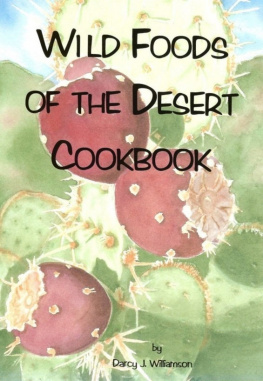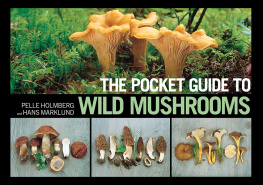Darcy Williamson - Fabulous Wild Fungi ~ Wildly Creative Cuisine
Here you can read online Darcy Williamson - Fabulous Wild Fungi ~ Wildly Creative Cuisine full text of the book (entire story) in english for free. Download pdf and epub, get meaning, cover and reviews about this ebook. year: 2010, publisher: Darcy Williamson, genre: Home and family. Description of the work, (preface) as well as reviews are available. Best literature library LitArk.com created for fans of good reading and offers a wide selection of genres:
Romance novel
Science fiction
Adventure
Detective
Science
History
Home and family
Prose
Art
Politics
Computer
Non-fiction
Religion
Business
Children
Humor
Choose a favorite category and find really read worthwhile books. Enjoy immersion in the world of imagination, feel the emotions of the characters or learn something new for yourself, make an fascinating discovery.
- Book:Fabulous Wild Fungi ~ Wildly Creative Cuisine
- Author:
- Publisher:Darcy Williamson
- Genre:
- Year:2010
- Rating:4 / 5
- Favourites:Add to favourites
- Your mark:
- 80
- 1
- 2
- 3
- 4
- 5
Fabulous Wild Fungi ~ Wildly Creative Cuisine: summary, description and annotation
We offer to read an annotation, description, summary or preface (depends on what the author of the book "Fabulous Wild Fungi ~ Wildly Creative Cuisine" wrote himself). If you haven't found the necessary information about the book — write in the comments, we will try to find it.
Fantastic Wild Fungi ~ Wildly Creative Cuisine guides you through the best way to prepare 22 species of wild edible mushrooms. The book offers over 200 recipes and hundreds of tips on when and where to find the different species, identification guide-lines, preserving your harvest for future use.
Fabulous Wild Fungi ~ Wildly Creative Cuisine — read online for free the complete book (whole text) full work
Below is the text of the book, divided by pages. System saving the place of the last page read, allows you to conveniently read the book "Fabulous Wild Fungi ~ Wildly Creative Cuisine" online for free, without having to search again every time where you left off. Put a bookmark, and you can go to the page where you finished reading at any time.
Font size:
Interval:
Bookmark:
FABULOUS WILD FUNGI~
WILDLY CREATIVE CUISINE
Revised Edition
BY
DARCY J. WILLIAMSON
Fabulous Wild Fungi ~Wildly Creative Cuisine
By
Darcy Williamson
Cover Artwork and Illustrations by
Marlee Wilcomb
Proofread by Linn Wallace
Dedicated to my mushroom hunting friend:
Marlee Wilcomb
Copyright 2015 by Darcy Williamson
All rights reserved. Without limiting therights under copyright reserved above, no part of this publicationmay be reproduced, stored in or introduced into a retrieval system,or transmitted, in any form, or by any means (electronic,mechanical, photocopying, recording, or otherwise) without theprior written permission of both the copyright owner and the abovepublisher of this book.
ISBN 978-1517512736
TABLE OF CONTENTS
Introduction
Mushroom Sense
Chapter 1 - Agaricus (Almond Mushroom, Giant Cypress, Agaricus, GiantHorse Mushroom, Horse Mushroom, Meadow Mushroom, Prince,Salt-Loving Agaricus, Tork
Chapter 2 - Auricularia auricula (Wood Ears)
Chapter 3 - Boletus (Admirable Bolete; Butter Bolete, King Bolete,Queen Bolete, White King Bolete)
Chapter 4 - Calvatia (Sierran Puffball, Giant Western
Chapter 5 - Cantharellus (White Chanterelle, YellowChanterelle)
Chapter 6 - Catathelasmaventricosa (Mock Matsutake)
Chapter 7 - Clitocybe (Blewit, Blue-Green Anise Mushroom)
Chapter 8 - Coprinuscomatus (Shaggy Mane)
Chapter 9 - Craterelluscornucopiodes (Horn of Plenty)
Chapter 10 - Gyromitra gigas (Snowbank False Morel)
Chapter 11 - Hericium (Bear's Head, Lion's Mane)
Chapter 12 - Hydnum repandum (Hedgehog Mushroom)
Chapter 13 - Lactarius (Candy Cap, Indigo Milk Cap)
Chapter 14 - Leccinuminsigne (Aspen Bolete)
Chapter 15 - Lepiota (Parasol, Shaggy Parasol)
Chapter 17 - Morchella (Black Morel, Common Morel, WhiteMorel)
Chapter 18 - Pleurotusostreatus (Oyster Mushroom)
Chapter 19 - Ramaria (Pink-Tipped Coral, Yellow Coral)
Chapter20 - Russulaxerampelina (Shrimp Mushroom)
Chapter 21 - Strophariarugoso-annulata (KingStropharia)
Chapter 22 - Tricholoma (Brown Matsutake, Man on Horseback, PoplarTricholoma, White Matsutake)
Bibliography
Introduction:
I find Snow Bank False Morels in thereceding wake of the snow. In the clearing beyond, the trillium isjust poking its furled green leaves through the new spring earthand the trout lily has yet to open its golden buds. There, lined upalong a deteriorating log are seven more of the mushrooms. Threehave lifted up through the snow still fringed along the border ofthe log.
Calfs brain is the local name for thisearly spring delicacy. Their wrinkled surface and rounded shape,combined with their burnt orange hue, is definitelycerebellum-like.
As I place the cool, moist fungi into mygathering basket I am experiencing my annual sense of elation andexpectation. This is just the beginning of the harvest of forestdelicacies. By the time the trillium has blossomed and its petalshave begun to tinge purple, the Morels will be making their grandappearance. Oyster Mushrooms will flush along the surface of fallentrees. Giant puffballs will form snowball-like aberrations amongthe alders and buck brush lining mountain trails. And with eachspring, summer and autumn shower Wood Ears will swell with moistureand hang rubber-like along surfaces of dead or dying birch.
In groves of aspen, when the trees haveunfurled their pale green leaves, the Aspen Bolete will clash withits surroundings. Amid the blues and purples of the larkspur, thecream of the bistort and the gold of the cowslip, the Bolete willblaze bright orange. Its boldness will be unmistakable. It neverblends nor disguises. Its large size and burnished hue arestartling when surrounded by the pastels of late spring. Throughits garishness the Bolete announces the arrival of summer.
Beside the mountain streams where coolcurrents of air pass over the rich loamy soil, the petal-likeChanterelles will push up through the forest floor. Some willstagger up the slopes, others will seek the shade of ferns andthimble berry patches. In nearby old growth forests of grand firthe timid Horn of Plenty will share space with the Hedgehog and thefragrant Clitocybe.
As the Western Larch turn flaxen and therains of autumn dampen the forest loam a frenzy of fungus willappear. Bears Head will hang like clumps of miniature icicles fromthe ends of fallen trees, taunting the coming winter with theirJack Frost impersonation. Fried Chicken Mushrooms and Shaggy Manewill line the packed soils of mountain and logging roads offeringthemselves to hapless deer and elk hunters, hence they not returnhome empty handed.
When the snow falls once more I will haverestocked my pantry with delicious dried, bottled and pickledmushrooms. Each jar will hold treasured memories of forestadventuresand the anticipation the coming spring. Meanwhile,should my palate be sated with nothing less than the sweetness offresh mushrooms, the produce section of the local market willprovide a variety of cultivated favorites.
MUSHROOM SENSE
What is a Mushroom?
It is a common idiom to use the termmushroom when referring to edible fungi and toadstool whenreferring to inedible or poisonous fungi. Personally, I have seennumerous inedible and some poisonous fungi, but their beauty anddistinctive characteristics have never brought to mindtoadstools. Therefore, I choose not to use the term.
Fungi are generally considered plants.However, they are quite distinct. They have no chlorophyll, roots,stems or leaves; plus, they have numerous features characteristicof themselves. If, as we are taught in school, the world is made upof plants, animals and minerals, I suppose we would have toclassify mushrooms as plants.
Typically, fungi are composed of a compacttangle of fine filaments, which is called a mycelium. Thesefilaments branch out into the materials from which they derivetheir nutrition. We seldom see the myceliumwhat we do see is thefruit, which we call mushrooms.
Since the absence of chlorophyll preventsthe fungi from accessing the carbon contained in the atmosphere, asgreen plants do, their mycelium must procure substance from otherorganisms. Some mushrooms are saprophytes, deriving their nutrientsfrom dead or decomposing organic matter such as manure, dry leaves,and compost. Some mushrooms are parasitic, consuming livingorganisms such as trees and plants. Most mushrooms, however, aresymbiotic, existing with another species, to the advantage of both.Tree roots, which often act as hosts for symbiotic mushrooms, canmore easily absorb nutrients from material decomposed by the fungi.Agaricus, Russula, Tricholoma, and Boletus are examples ofsymbiotic mushrooms. All these fungi depend upon a certain kind oftree, shrub or bush for their survivalas do certain trees dependon the mushrooms for theirs.
Cultivated Exotics
Although a wide variety of cultivated fungihave graced the European markets for hundreds of years, it has onlybeen within the last ten years that mushroom factories havesprung up in North America to meet the increasing demand for exoticmushrooms. Produce and farmers markets throughout the country nowoffer the consumer delectable alternatives to the insipid whitebutton mushrooms that come in a box! But it hasnt been an easytask.
The complicated connection between fungi andthe medium in which they grow makes cultivation of mushrooms adifficult, and in some cases an impossible, project. The techniqueof growing cultivated mushrooms lies in injecting mycelium into agrowing situation as similar as possible to the naturalconditions.
After a period of incubation, the myceliumstarts to spread in the form of whitish filaments. Months followinginoculation the shapes of the fruiting bodies begin to appear. Theentire process may take up to eight months, depending on thevariety of mushroom being cultivated. Some of the cultivatedvarieties include Oyster Mushrooms, Wood Ears, Lions Mane, severalAgaricus, and the King Stropharia.
Next pageFont size:
Interval:
Bookmark:
Similar books «Fabulous Wild Fungi ~ Wildly Creative Cuisine»
Look at similar books to Fabulous Wild Fungi ~ Wildly Creative Cuisine. We have selected literature similar in name and meaning in the hope of providing readers with more options to find new, interesting, not yet read works.
Discussion, reviews of the book Fabulous Wild Fungi ~ Wildly Creative Cuisine and just readers' own opinions. Leave your comments, write what you think about the work, its meaning or the main characters. Specify what exactly you liked and what you didn't like, and why you think so.














